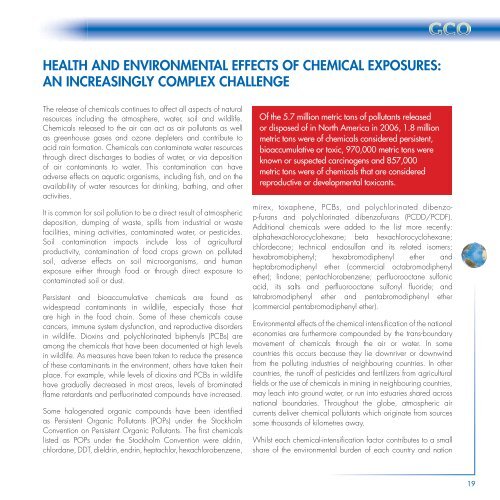Global Chemicals Outlook - UNEP
Global Chemicals Outlook - UNEP
Global Chemicals Outlook - UNEP
Create successful ePaper yourself
Turn your PDF publications into a flip-book with our unique Google optimized e-Paper software.
HEALTH AND ENVIRONMENTAL EFFECTS OF CHEMICAL EXPOSURES:<br />
AN INCREASINGLY COMPLEX CHALLENGE<br />
The release of chemicals continues to affect all aspects of natural<br />
resources including the atmosphere, water, soil and wildlife.<br />
<strong>Chemicals</strong> released to the air can act as air pollutants as well<br />
as greenhouse gases and ozone depleters and contribute to<br />
acid rain formation. <strong>Chemicals</strong> can contaminate water resources<br />
through direct discharges to bodies of water, or via deposition<br />
of air contaminants to water. This contamination can have<br />
adverse effects on aquatic organisms, including fi sh, and on the<br />
availability of water resources for drinking, bathing, and other<br />
activities.<br />
It is common for soil pollution to be a direct result of atmospheric<br />
deposition, dumping of waste, spills from industrial or waste<br />
facilities, mining activities, contaminated water, or pesticides.<br />
Soil contamination impacts include loss of agricultural<br />
productivity, contamination of food crops grown on polluted<br />
soil, adverse effects on soil microorganisms, and human<br />
exposure either through food or through direct exposure to<br />
contaminated soil or dust.<br />
Persistent and bioaccumulative chemicals are found as<br />
widespread contaminants in wildlife, especially those that<br />
are high in the food chain. Some of these chemicals cause<br />
cancers, immune system dysfunction, and reproductive disorders<br />
in wildlife. Dioxins and polychlorinated biphenyls (PCBs) are<br />
among the chemicals that have been documented at high levels<br />
in wildlife. As measures have been taken to reduce the presence<br />
of these contaminants in the environment, others have taken their<br />
place. For example, while levels of dioxins and PCBs in wildlife<br />
have gradually decreased in most areas, levels of brominated<br />
fl ame retardants and perfl uorinated compounds have increased.<br />
Some halogenated organic compounds have been identifi ed<br />
as Persistent Organic Pollutants (POPs) under the Stockholm<br />
Convention on Persistent Organic Pollutants. The fi rst chemicals<br />
listed as POPs under the Stockholm Convention were aldrin,<br />
chlordane, DDT, dieldrin, endrin, heptachlor, hexachlorobenzene,<br />
Of the 5.7 million metric tons of pollutants released<br />
or disposed of in North America in 2006, 1.8 million<br />
metric tons were of chemicals considered persistent,<br />
bioaccumulative or toxic, 970,000 metric tons were<br />
known or suspected carcinogens and 857,000<br />
metric tons were of chemicals that are considered<br />
reproductive or developmental toxicants.<br />
mirex, toxaphene, PCBs, and polychlorinated dibenzop-furans<br />
and polychlorinated dibenzofurans (PCDD/PCDF).<br />
Additional chemicals were added to the list more recently:<br />
alphahexachlorocyclohexane; beta hexachlorocyclohexane;<br />
chlordecone; technical endosulfan and its related isomers;<br />
hexabromobiphenyl; hexabromodiphenyl ether and<br />
heptabromodiphenyl ether (commercial octabromodiphenyl<br />
ether); lindane; pentachlorobenzene; perfl uorooctane sulfonic<br />
acid, its salts and perfl uorooctane sulfonyl fl uoride; and<br />
tetrabromodiphenyl ether and pentabromodiphenyl ether<br />
(commercial pentabromodiphenyl ether).<br />
Environmental effects of the chemical intensifi cation of the national<br />
economies are furthermore compounded by the trans-boundary<br />
movement of chemicals through the air or water. In some<br />
countries this occurs because they lie downriver or downwind<br />
from the polluting industries of neighbouring countries. In other<br />
countries, the runoff of pesticides and fertilizers from agricultural<br />
fi elds or the use of chemicals in mining in neighbouring countries,<br />
may leach into ground water, or run into estuaries shared across<br />
national boundaries. Throughout the globe, atmospheric air<br />
currents deliver chemical pollutants which originate from sources<br />
some thousands of kilometres away.<br />
Whilst each chemical-intensifi cation factor contributes to a small<br />
share of the environmental burden of each country and nation<br />
19

















